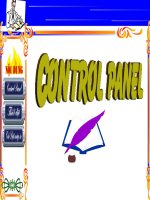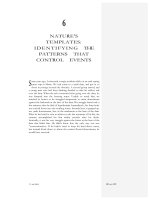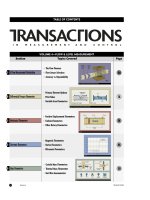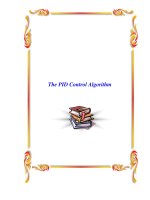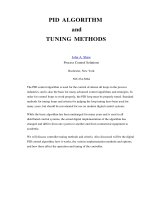PID CONTROL
Bạn đang xem bản rút gọn của tài liệu. Xem và tải ngay bản đầy đủ của tài liệu tại đây (235.87 KB, 11 trang )
PID controller
(Redirected from PID control)
Jump to: navigation, search
A proportional-integral-derivative controller (PID controller) is a generic control loop
feedback mechanism widely used in industrial control systems. A PID controller attempts to
correct the error between a measured process variable and a desired setpoint by calculating
and then outputting a corrective action that can adjust the process accordingly.
The PID controller calculation (algorithm) involves three separate parameters; the
Proportional, the Integral and Derivative values. The Proportional value determines the
reaction to the current error, the Integral determines the reaction based on the sum of recent
errors and the Derivative determines the reaction to the rate at which the error has been
changing. The weighted sum of these three actions is used to adjust the process via a control
element such as the position of a control valve or the power supply of a heating element.
By "tuning" the three constants in the PID controller algorithm the PID can provide control
action designed for specific process requirements. The response of the controller can be
described in terms of the responsiveness of the controller to an error, the degree to which the
controller overshoots the setpoint and the degree of system oscillation. Note that the use of the
PID algorithm for control does not guarantee optimal control of the system.
Some applications may require using only one or two modes to provide the appropriate
system control. This is achieved by setting the gain of undesired control outputs to zero. A
PID controller will be called a PI, PD, P or I controller in the absence of the respective control
actions. PI controllers are particularly common, since derivative action is very sensitive to
measurement noise, and the absence of an integral value prevents the system from reaching its
target value due to the control action.
A block diagram of a PID controller
Note: Due to the diversity of the field of control theory and application, many naming
conventions for the relevant variables are in common use.
Contents
[hide] [hide]
• 1 Control loop basics
• 2 PID controller theory
o 2.1 Proportional term
o 2.2 Integral term
o 2.3 Derivative term
o 2.4 Summary
• 3 Loop tuning
o 3.1 Ziegler-Nichols method
o 3.2 PID tuning software
• 4 Modifications to the PID algorithm
• 5 Limitations of PID control
• 6 Physical implementation of PID control
• 7 Alternative Nomenclature and PID forms
o 7.1 Pseudocode
o 7.2 Ideal vs Standard PID form
o 7.3 Series / interacting form
• 8 See also
• 9 External links
o 9.1 PID tutorials
o 9.2 Simulations
o 9.3 Special topics and PID control applications
• 10 References
[edit] Control loop basics
A familiar example of a control loop is the action taken to keep one's shower water at the
ideal temperature. The person feels the water to estimate its temperature. Based on this
measurement they perform a control action: use the hot water tap to adjust the process. The
person would repeat this input-output control loop, adjusting the hot water flow until the
process temperature stabilized at the desired value.
Feeling the water temperature is taking a measurement of the process value or process
variable (PV). The desired temperature is called the setpoint (SP). The output from the
controller and input to the process (the tap position) is called the manipulated variable
(MV). The difference between the measurement and the setpoint is the error (e), too hot or
too cold and by how much.
As a controller, one decides roughly how much to change the tap position (MV) after one
determines the temperature (PV), and therefore the error. This first estimate is the equivalent
of the proportional action of a PID controller. The integral action of a PID controller can be
thought of as gradually adjusting the temperature when it is almost right. Derivative action
can be thought of as making smaller and smaller changes as one gets close to the right
temperature and stopping when it is just right, rather than going too far.
Making a change that is too large when the error is small is equivalent to a high gain
controller and will lead to overshoot. If the controller were to repeatedly make changes that
were too large and repeatedly overshoot the target, this control loop would be termed
unstable and the output would oscillate around the setpoint in either a constant, a growing or
a decaying sinusoid. A human would not do this because we are adaptive controllers, learning
from the process history, but PID controllers do not have the ability to learn and must be set
up correctly. Selecting the correct gains for effective control is known as tuning the
controller.
If a controller starts from a stable state at zero error (PV = SP), then further changes by the
controller will be in response to changes in other measured or unmeasured inputs to the
process that impact on the process, and hence on the PV. Variables that impact on the process
other than the MV are known as disturbances and generally controllers are used to reject
disturbances and/or implement setpoint changes. Changes in feed water temperature constitute
a disturbance to the shower process.
In theory, a controller can be used to control any process which has a measurable output (PV),
a known ideal value for that output (SP) and an input to the process (MV) that will affect the
relevant PV. Controllers are used in industry to regulate temperature, pressure, flow rate,
chemical composition, level in a tank containing fluid, speed and practically every other
variable for which a measurement exists. Automobile cruise control is an example of a
process which utilizes automated control.
Due to their long history, simplicity, well grounded theory and simple setup and maintenance
requirements, PID controllers are the controllers of choice for many of these applications.
[edit] PID controller theory
Note: This section describes the ideal parallel or non-interacting form of the PID controller.
For other forms please see the Section "Alternative notation and PID forms".
The PID control scheme is named after its three correcting terms, whose sum constitutes the
manipulated variable (MV). Hence:
where P
out
, I
out
, and D
out
are the contributions to the output from the PID controller from each
of the three terms, as defined below.
[edit] Proportional term
The proportional term makes a change to the output that is proportional to the current error
value. The proportional response can be adjusted by multiplying the error by a constant K
p
,
called the proportional gain.
The proportional term is given by:
Where
• P
out
: Proportional output
• K
p
: Proportional Gain, a tuning parameter
• e: Error = SP − PV
• t: Time or instantaneous time (the present)
Change of response for varying Kp
A high proportional gain results in a large change in the output for a given change in the error.
If the proportional gain is too high, the system can become unstable (See the section on Loop
Tuning). In contrast, a small gain results in a small output response to a large input error, and
a less responsive (or sensitive) controller. If the proportional gain is too low, the control
action may be too small when responding to system disturbances.
In the absence of disturbances pure proportional control will not settle at its target value, but
will retain a steady state error that is a function of the proportional gain and the process gain.
Despite the steady-state offset, both tuning theory and industrial practice indicate that it is the
proportional term that should contribute the bulk of the output change.
[edit] Integral term
The contribution from the integral term is proportional to both the magnitude of the error and
the duration of the error. Summing the instantaneous error over time (integrating the error)
gives the accumulated offset that should have been corrected previously. The accumulated
error is then multiplied by the integral gain and added to the controller output. The magnitude
of the contribution of the integral term to the overall control action is determined by the
integral gain, K
i
.
The integral term is given by:
Change of response for varying Ki
Where
• I
out
: Integral output
• K
i
: Integral Gain, a tuning parameter
• e: Error = SP − PV
• τ: Time in the past contributing to the integral response
The integral term (when added to the proportional term) accelerates the movement of the
process towards setpoint and eliminates the residual steady-state error that occurs with a
proportional only controller. However, since the integral term is responding to accumulated
errors from the past, it can cause the present value to overshoot the setpoint value (cross over
the setpoint and then create a deviation in the other direction). For further notes regarding
integral gain tuning and controller stability, see the section on Loop Tuning.
[edit] Derivative term
The rate of change of the process error is calculated by determining the slope of the error over
time (i.e. its first derivative with respect to time) and multiplying this rate of change by the
derivative gain K
d
. The magnitude of the contribution of the derivative term to the overall
control action is termed the derivative gain, K
d
.
The derivative term is given by:
Change of response for varying Kd
Where
• D
out
: Derivative output
• K
d
: Derivative Gain, a tuning parameter
• e: Error = SP − PV
• t: Time or instantaneous time (the present)
The derivative term slows the rate of change of the controller output and this effect is most
noticeable close to the controller setpoint. Hence, derivative control is used to reduce the
magnitude of the overshoot produced by the integral component and improve the combined
controller-process stability. However, differentiation of a signal amplifies noise in the signal
and thus this term in the controller is highly sensitive to noise in the error term, and can cause
a process to become unstable if the noise and the derivative gain are sufficiently large.
[edit] Summary
The output from the three terms, the proportional, the integral and the derivative terms are
summed to calculate the output of the PID controller. Defining u(t) as the controller output,
the final form of the PID algorithm is:
and the tuning parameters are
1. K
p
: Proportional Gain - Larger K
p
typically means faster response since the larger the
error, the larger the feedback to compensate. An excessively large proportional gain
will lead to process instability.
2. K
i
: Integral Gain - Larger K
i
implies steady state errors are eliminated quicker. The
trade-off is larger overshoot: any negative error integrated during transient response
must be integrated away by positive error before we reach steady state.
3. K
d
: Derivative Gain - Larger K
d
decreases overshoot, but slows down transient
response and may lead to instability.
[edit] Loop tuning
If the PID controller parameters (the gains of the proportional, integral and derivative terms)
are chosen incorrectly, the controlled process input can be unstable, i.e. its output diverges,
with or without oscillation, and is limited only by saturation or mechanical breakage. Tuning
a control loop is the adjustment of its control parameters (gain/proportional band, integral
gain/reset, derivative gain/rate) to the optimum values for the desired control response.
The optimum behavior on a process change or setpoint change varies depending on the
application. Some processes must not allow an overshoot of the process variable beyond the
setpoint if, for example, this would be unsafe. Other processes must minimize the energy
expended in reaching a new setpoint. Generally, stability of response (the reverse of
instability) is required and the process must not oscillate for any combination of process
conditions and setpoints. Some processes have a degree of non-linearity and so parameters
that work well at full-load conditions don't work when the process is starting up from no-load.
This section describes some traditional manual methods for loop tuning.
There are several methods for tuning a PID loop. The most effective methods generally
involve the development of some form of process model, then choosing P, I, and D based on
the dynamic model parameters. Manual "tune by feel" methods can be inefficient.
The choice of method will depend largely on whether or not the loop can be taken "offline"
for tuning, and the response time of the system. If the system can be taken offline, the best
tuning method often involves subjecting the system to a step change in input, measuring the
output as a function of time, and using this response to determine the control parameters.
Choosing a Tuning Method
Method Advantages Disadvantages
Ziegler-
Nichols
Proven Method. Online method.
Process upset, some trial-and-
error, very aggressive tuning
Tune By
Feel
No math required. Online method. Erratic, not repeatable
Software
Tools
Consistent tuning. Online or offline method. May
include valve and sensor analysis. Allow
simulation before downloading.
Some cost and training
involved.
Cohen-
Coon
Good process models.
Some math. Offline method.
Only good for first-order
processes.
If the system must remain online, one tuning method is to first set the I and D values to zero.
Increase the P until the output of the loop oscillates, then the P should be left set to be
approximately half of that value for a "quarter amplitude decay" type response. Then increase
I until any offset is correct in sufficient time for the process. However, too much I will cause
instability. Finally, increase D, if required, until the loop is acceptably quick to reach its
reference after a load disturbance. However, too much D will cause excessive response and
overshoot. A fast PID loop tuning usually overshoots slightly to reach the setpoint more
quickly; however, some systems cannot accept overshoot, in which case an "over damped"
tune is required, which will require a P setting significantly less than half that of the P setting
causing oscillation.
Effects of increasing parameters
Parameter Rise Time Overshoot Settling Time S.S. Error
K
p
Decrease Increase Small Change Decrease
K
i
Decrease Increase Increase Eliminate
K
d
Small Change Decrease Decrease None
[edit] Ziegler-Nichols method
Another tuning method is formally known as the Ziegler-Nichols method, introduced by John
G. Ziegler and Nathaniel B. Nichols. As in the method above, the I and D gains are first set to
zero. The "P" gain is increased until it reaches the "critical gain" K
c
at which the output of the
loop starts to oscillate. K
c
and the oscillation period P
c
are used to set the gains as shown:
Ziegler-Nichols method
Control Type K
p
K
i
K
d
P 0.5·K
c
- -
PI
0.45·K
c
1.2K
p
/ P
c
-
PID 0.6·K
c
2K
p
/ P
c
K
p
P
c
/ 8
[edit] PID tuning software
Most modern industrial facilities no longer tune loops using the manual calculation methods
shown above. Instead, PID tuning and loop optimization software are used to ensure
consistent results. These software packages will gather the data, develop process models, and
suggest optimal tuning. Some software packages can even develop tuning by gathering data
from reference changes.
Mathematical PID loop tuning induces an impulse in the system, and then uses the controlled
system's frequency response to design the PID loop values. In loops with response times of
several minutes, mathematical loop tuning is recommended, because trial and error can
literally take days just to find a stable set of loop values. Optimal values are harder to find.
Some digital loop controllers offer a self-tuning feature in which very small setpoint changes
are sent to the process, allowing the controller itself to calculate optimal tuning values.
Other formulas are available to tune the loop according to different performance criteria.
[edit] Modifications to the PID algorithm
The basic PID algorithm presents some challenges in control applications that have been
addressed by minor modifications to the PID form.
One common problem resulting from the ideal PID implementations is integral windup. This
can be addressed by:
• Initializing the controller integral to a desired value, commonly the process present
value for startup problems
• Disabling the integral function until the PV has entered the controllable region
• Limiting the time period over which the integral error is calculated
• Preventing the integral term from accumulating above or below pre-determined
bounds
Many PID loops control a mechanical device (for example, a valve). Mechanical maintenance
can be a major cost and wear leads to control degradation in the form of either stiction or a
deadband in the mechanical response to an input signal. The rate of mechanical wear is
mainly a function of how often a device is activated to make a change. Where wear is a
significant concern, the PID loop may have an output deadband to reduce the frequency of
activation of the output (valve). This is accomplished by modifying the controller to hold its
output steady if the change would be small (within the defined deadband range). The
calculated output must leave the deadband before the actual output will change.
The proportional and differential terms can produce excessive movement in the output when a
system is subjected to an instantaneous "step" increase in the error, such as a large setpoint
change. In the case of the derivative term, this is due to taking the derivative of the error,
which is very large in the case of an instantaneous step change. As a result, some PID
algorithms incorporate the following modifications:
• derivative of output In this case the PID controller measures the differential of the
output quantity, rather than the derivative of the error. The output is always continuous
(i.e., never has a step change). For this to be effective, the derivative of the output
must have the same sign as the derivative of the error.
• setpoint ramping In this modification, the setpoint is gradually moved from its old
value to a newly specified value using a linear or first order differential ramp function.
This avoids the discontinuity present in a simple step change.
• setpoint weighting Setpoint weighting uses different multipliers for the error
depending on which element of the controller it is used in. The error in the integral
term must be the true control error to avoid steady-state control errors. This affects the
controller's setpoint response. These parameters do not affect the response to load
disturbances and measurement noise.
[edit] Limitations of PID control
While PID controllers are applicable to many control problems, they can perform poorly in
some applications.
PID controllers, when used alone, can give poor performance when the PID loop gains must
be reduced so that the control system does not overshoot, oscillate or "hunt" about the control
setpoint value. The control system performance can be improved by combining the PID
controller functionality with that of a Feed-Forward control output as described in Control
Theory. Any information or intelligence derived from the system state can be "fed forward" or
combined with the PID output to improve the overall system performance. The Feed-Forward
value alone can often provide a major portion of the controller output. The PID controller can
then be used to respond to whatever difference or "error" that remains between the controller
setpoint and the feedback value. Since the Feed-Forward output is not a function of the
process feedback, it can never cause the control system to oscillate, thus improving the system
response and stability.
For example, in most motion control systems, in order to accelerate a mechanical load under
control, more force or torque is required from the prime mover, motor or actuator. If a
velocity loop PID controller is being used to control the speed of the load and command the
force or torque being applied by the prime mover, then it is beneficial to take the
instantaneous acceleration desired for the load, scale that value appropriately and add it to the
output of the PID velocity loop controller. This means that whenever the load is being
accelerated or decelerated, a proportional amount of force is commanded from the prime
mover regardless of the feedback value. The PID loop in this situation uses the feedback
information to effect any increase or decrease of the combined output in order to reduce the
remaining difference between the process setpoint and the feedback value. Working together,
the combined Feed-Forward open loop controller and closed loop PID controller can provide
more responsive, stable and reliable control systems.
Another problem faced with PID controllers is that they are linear. Thus, performance of PID
controllers in non-linear systems (such as HVAC systems) is variable. Often PID controllers
are enhanced through methods such as gain scheduling or fuzzy logic. Further practical
application issues can arise from instrumentation connected to the controller. A high enough
sampling rate and measurement precision and measurement accuracy (more relevant to FF
and MPC).
A problem with the differential term is that small amounts of measurement or process noise
can cause large amounts of change in the output. Sometimes it is helpful to filter the
measurements, with a running average, also known as a low-pass filter. However, low-pass
filtering and derivative control cancel each other out, so reducing noise by instrumentation
means is a much better choice. Alternatively, the differential band can be turned off in most
systems with little loss of control. This is equivalent to using the PID controller as a PI
controller.
[edit] Physical implementation of PID control
In the early history of automatic process control the PID controller was implemented as a
mechanical device. These mechanical controllers used a lever, spring and a mass and were
often energized by compressed air. These pneumatic controllers were once the industry
standard.
Electronic analog controllers can be made from a solid-state or tube amplifier, a capacitor and
a resistance. Electronic analog PID control loops were often found within more complex
electronic systems, for example, the head positioning of a disk drive, the power conditioning
of a power supply, or even the movement-detection circuit of a modern seismometer.
Nowadays, electronic controllers have largely been replaced by digital controllers
implemented with microcontrollers or FPGAs.
Most modern PID controllers in industry are implemented in software in programmable logic
controllers (PLCs) or as a panel-mounted digital controller. Software implementations have
the advantages that they are relatively cheap, highly reliable and reasonably flexible with
respect to the implementation of the PID algorithm.
[edit] Alternative Nomenclature and PID forms
[edit] Pseudocode
Here is a simple software loop that implements the PID algorithm:
start:
previous_error = error or 0 if undefined
error = setpoint - actual_position
P = Kp * error
I = I + Ki * error * dt
D = Kd * (error - previous_error) / dt
output = P + I + D
wait(dt)
goto start
[edit] Ideal vs Standard PID form
Note that the form of the PID controller most often encountered in industry, and the one most
relevant to tuning algorithms is the "standard form". In this form the K
p
gain is applied to the
I
out
, and D
out
terms, yielding:
Where
T
i
is the Integral Time
T
d
is the Derivative Time
In the ideal parallel form, shown in the Controller Theory section
the gain parameters are related to the parameters of the standard form through and
K
d
= K
p
T
d
. This parallel form, where the parameters are treated as simple gains, is the most
general and flexible form. However, it is also the form where the parameters have the least
physical interpretation and is generally reserved for theoretical treatment of the PID
controller. The "standard" form, despite being slightly more complex mathematically, is more
common in industry.
